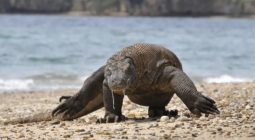California zombie lake turned farmland to water. A year later, is it gone for good?
Tulare Lake was resurrected to more than 100,000 acres, bringing fear and wonder. I went to see it – and couldn’t find it
For a time last year, it was difficult to drive through a large swath of central California without running into the new shoreline of a long dormant lake.
Resurrected for the first time in decades by an epic deluge of winter rain and snow, by spring the lake covered more than 100,000 acres, stretching over cotton, tomato and pistachio fields and miles of roads.
Tulare Lake, or Pa’ashi as it is known to the Tachi Yokut Tribe, was back.
The scene was astounding. Tulare Lake was once the largest freshwater body west of the Mississippi before it was drained for agriculture in the 19th century. While it has re-emerged during other periods of wet weather, the lake hadn’t been seen anywhere near this scale in 40 years.
Its resurrection sparked a flurry of visitors and news coverage. Scientists and officials predicted the lake could remain for years to come, sparking consternation among the local farmers whose land was now underwater, and excitement from others who saw the lake as a fertile nature sanctuary and sacred site.
Yet today, such fears and hopes have not borne out entirely as expected. Along a narrow and dusty back road in Kings county, California’s agricultural heartland, there are sprouts of grass and thick mud, but no signs of the body of water. Despite the predictions, the lake is nearly gone.
Tulare Lake has shrunk to just 2,625 acres, according to the Kings county office of emergency services. Officials expect its “imminent disappearance”, said Abraham Valencia, with the office of emergency services, “barring unforeseen snowmelt runoff causing upstream flooding”. The lake covered private land, and now some farming is resuming, Nate Ferrier with the county sheriff’s office told a local news outlet.
“We’ve got tractors and trucks moving around and fields are getting prepared to start growing crops again,” Ferrier said.
Most Californians had only known of Tulare Lake from historical accounts. Before its vast expanse was replaced by endless rows of nut trees, Pima cotton and safflowers, the lake was home to turtles and beavers and was surrounded by tule reeds.
It has reappeared a handful of times in the past century, including in 1998, and most dramatically last winter, when back-to-back atmospheric river storms walloped the state from December to March. Water overtook what is typically a dry landscape, covering acres and acres of crops – and for a time threatened towns in the area and forced the evacuation of thousands of cows, as well as roads and power lines.
While the inundation was a hardship to the agriculture industry and area workers, it captivated many people. Visitors flocked to new viewing points and road closure signs with drones, although officials warned them to stay out of the water, which was laden with irrigation hoses, manure and agricultural chemicals.
The scene that greeted them was blue as far as the eye could see, with wildlife returning to the area – fish swimming along submerged fence poles and birds bobbing around the shoreline.
“You’re driving along and the road just ends – it just ducks under the water,” said Vivian Underhill, a feminist scholar of environmental justice who has studied the lake. “You see these nut trees just filled with water, ducks swimming under the shade of almond trees. “You could see blackbirds, hawks, geese. You could hear fish splashing out of the water.”
By last summer, the lake covered an area roughly the side of Lake Tahoe and was between 5 to 7ft deep. Its re-emergence was particularly meaningful to the Tachi, who revere the lake their ancestors relied on before settlers forced the tribe out of the area and drained it to make way for crops. In their creation stories, the Tachi were made from the sediment at the bottom of the lake, Underhill said.
Tribal members grew up hearing stories about how the lake that once supported the Tachi was taken from them, the Los Angeles Times reported. They had hoped to see the lake remain in place rather than be drained to resume agriculture as it had in the past.
“I am very happy the lake is back,” Leo Sisco, the chairman of the Santa Rosa Rancheria Tachi Yokut Tribe, told the newspaper last year. “It makes me swell with pride to know that, in this lifetime, I get to experience it. My daughters, my grandson get to experience the lake, and the stories that we heard when we were kids, for us it comes to fruition.”
These days the crowds of eager tourists have waned, and the shoreline is getting harder to find. On a recent drive through the central valley, I decided to try my best to see what was left of it.
On a sunny afternoon in late February, almost a year after its arrival, the road closure signs still in place around the county served as the most visible reminder of the lake. They blocked long stretches of muddy roads leading to agricultural facilities.
The remnants of Tulare Lake are located entirely on private land, far from where the public can see it. It has reduced rapidly in size as local agencies moved water from the lake to nearby farmlands. Evaporation also played a “key role”.
Pacific Gas & Electric, the area’s power utility, undertook a huge effort to retrieve its equipment that was submerged by the lake last year – in some cases using helicopters and dive teams. It has slowly begun restoring services to its customers in the area, which are primarily agricultural, said Denny Boyles, a company spokesperson.
Its re-emergence is estimated to have caused losses of hundreds of millions of dollars to the area’s agricultural industry. Local officials have expressed gratitude that some farmers can resume work.
“Farming is the lifeblood for Kings county. One in four jobs in this county are agricultural related, and so it’s one of our biggest commodities,” Ferrier said.
But this won’t be the last we hear of Tulare Lake. With the climate crisis intensifying California’s wet and dry extremes, the lake will probably continue to return in wet years, Jay Lund, a professor of civil and environmental engineering at University of California, Davis, wrote last year.
And allowing the lake to remain could offer benefits by recharging diminishing groundwater and boosting wildlife in the area, Underhill said. The aquifer in the lake basin, land that is predominantly owned by the agricultural giant JG Boswell Company, has been significantly depleted, which has caused the land in the area to sink.
“Any attempts to make this anything other than a lake bed are going to face the powers of floodwater eventually,” Underhill said. “It behooves us to let it remain as is because that’s clearly where the water wants to go, and it’s going to continue to go there.”
The lake is the natural state of this area, she added.
“It was such a rich and kind of teeming ecosystem. It says something about how the birds, the fish, they’re always waiting for the lake to return. And when it returns they are ready to go and be a part of it.”
Cover photo: Floodwaters rise in Tulare Lake basin, engulfing a road in Helm Corner, California, on 18 May 2023. Photograph: Caroline Brehman/EPA




